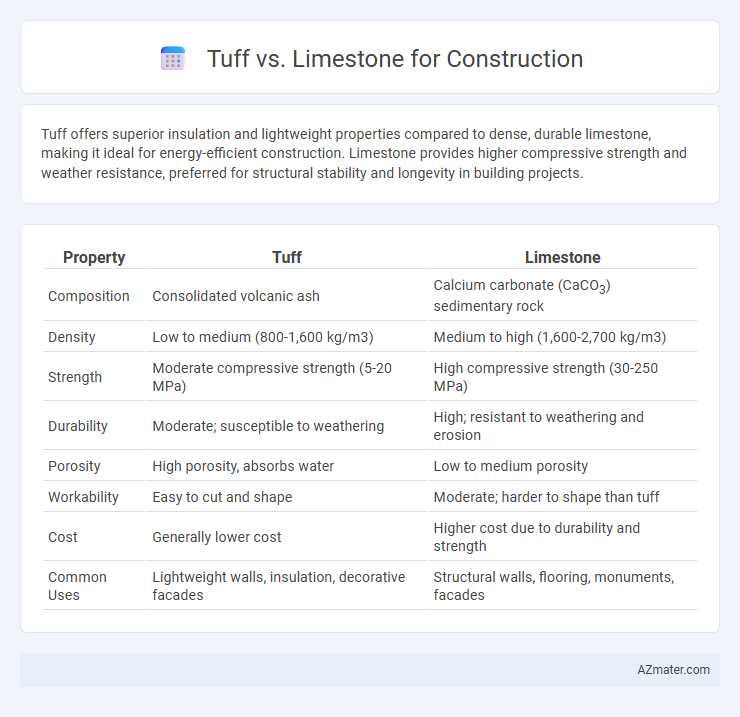Tuff offers superior insulation and lightweight properties compared to dense, durable limestone, making it ideal for energy-efficient construction. Limestone provides higher compressive strength and weather resistance, preferred for structural stability and longevity in building projects.
Table of Comparison
| Property | Tuff | Limestone |
|---|---|---|
| Composition | Consolidated volcanic ash | Calcium carbonate (CaCO3) sedimentary rock |
| Density | Low to medium (800-1,600 kg/m3) | Medium to high (1,600-2,700 kg/m3) |
| Strength | Moderate compressive strength (5-20 MPa) | High compressive strength (30-250 MPa) |
| Durability | Moderate; susceptible to weathering | High; resistant to weathering and erosion |
| Porosity | High porosity, absorbs water | Low to medium porosity |
| Workability | Easy to cut and shape | Moderate; harder to shape than tuff |
| Cost | Generally lower cost | Higher cost due to durability and strength |
| Common Uses | Lightweight walls, insulation, decorative facades | Structural walls, flooring, monuments, facades |
Introduction to Tuff and Limestone
Tuff is a volcanic rock composed of compacted ash and fragmented volcanic materials, known for its lightweight and porous structure, making it suitable for insulation and easy to shape in construction projects. Limestone, a sedimentary rock primarily made of calcium carbonate, is valued for its durability, strength, and wide availability, often used in foundations, walls, and decorative facades. Both materials possess distinct physical properties impacting their suitability for specific structural and aesthetic applications in building construction.
Geological Formation and Composition
Tuff, formed from consolidated volcanic ash, is characterized by its lightweight and porous texture, making it advantageous for insulation and ease of cutting in construction. Limestone, a sedimentary rock primarily composed of calcium carbonate from marine organism remains, offers high compressive strength and durability, suitable for structural applications. The contrasting geological origins of tuff and limestone influence their physical properties and optimal uses in construction projects.
Physical and Mechanical Properties
Tuff exhibits lower density and compressive strength compared to limestone, making it more lightweight but less durable for heavy load-bearing structures. Limestone features higher hardness and better resistance to abrasion, contributing to its widespread use in foundations and architectural detailing. Both stones vary in porosity, with limestone generally showing lower water absorption, enhancing its weather resistance in construction applications.
Durability and Weather Resistance
Tuff, a volcanic rock, exhibits lower durability and weather resistance compared to dense limestone, which is prized for its strength and longevity in construction. Limestone's low porosity and crystalline structure enhance its resistance to freeze-thaw cycles and chemical weathering, making it suitable for exterior and structural applications. Tuff's softer, more porous nature leads to higher susceptibility to erosion and environmental degradation, limiting its use in heavily exposed or load-bearing structures.
Workability and Ease of Use
Tuff offers superior workability due to its softer texture, making it easier to cut, shape, and handle during construction compared to limestone's denser and harder composition. Limestone requires more effort and specialized tools for precise carving and shaping, which can increase labor time and costs. This enhanced ease of use makes tuff a preferred material for intricate architectural details and rapid construction projects.
Environmental Impact and Sustainability
Tuff offers a lower environmental footprint than limestone due to its natural volcanic origin, which requires less extraction energy and produces fewer greenhouse gas emissions during quarrying. Limestone quarrying often leads to significant landscape disruption and higher carbon dioxide emissions from calcination processes. Choosing tuff supports sustainable construction by promoting materials with reduced ecological impact and enhanced resource renewability.
Cost Comparison and Availability
Tuff, a volcanic rock, generally offers a lower cost compared to limestone due to its abundance in volcanic regions and easier extraction processes. Limestone is widely available globally but often incurs higher transportation and quarrying expenses, influencing its overall price. Cost efficiency for construction depends on local availability, with tuff favored in volcanic areas and limestone preferred where it is naturally prevalent.
Common Construction Applications
Tuff offers excellent thermal insulation and lightweight properties, making it ideal for residential walls and decorative facades, whereas limestone provides superior compressive strength suited for load-bearing structures and exterior cladding. Both materials are commonly utilized in foundation work, retaining walls, and pavement, with tuff often preferred in seismic zones due to its flexibility. Limestone's durability and resistance to weathering make it a favored choice for monuments, bridges, and historical restorations.
Aesthetic Differences and Design Implications
Tuff, with its porous texture and warm earthy tones, offers a rustic, natural aesthetic that enhances Mediterranean or historic architectural styles, while limestone's smooth surface and variable color palette--from creamy whites to subtle grays--provide a more refined, classical appearance suited for modern and traditional designs. The choice between tuff and limestone impacts facade treatments, as tuff's irregularities create dynamic shadows and visual depth whereas limestone allows for precise carving and crisp detailing. Design implications include considerations of weathering patterns, where tuff may develop a patina that accentuates texture, contrasting with limestone's potential for cleaner, sleek lines over time.
Choosing the Right Stone: Key Considerations
Tuff and limestone differ significantly in durability, porosity, and load-bearing capacity, making the choice crucial for specific construction needs. Tuff is a lightweight, porous volcanic rock ideal for insulation and decorative facades, while limestone provides greater strength and durability suitable for structural elements. Consideration of environmental exposure, structural demands, and aesthetic preferences ensures optimal stone selection for longevity and performance.

Infographic: Tuff vs Limestone for Construction
 azmater.com
azmater.com